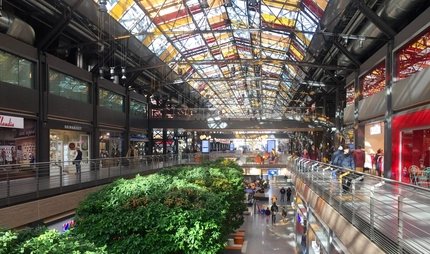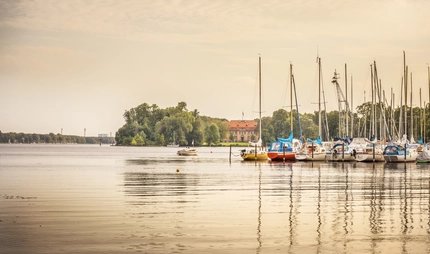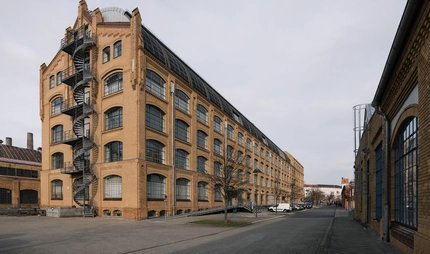
IBA buildings in Alt-Tegel
Built close to the waterfront
Standing at Tegel harbour are residential and cultural buildings in postmodern design which have a close connection to the water.
The 1987 International Building Exhibition (IBA) was a large-scale project to upgrade West Berlin's housing stock. In contrast to the urban development concepts of the 1950s to 1970s, the construction of new residential areas was no longer the issue at that time. Instead, the focus was on the renovation of old buildings and the integration of new houses into the existing inner city. One of the IBA projects that attracted a lot of international attention was located at the old Tegel harbour.
New residential quarter in Alt-Tegel
At the IBA, a particular focus lay on the planning of neighbourhoods that offered both living space as well as cultural and leisure opportunities. The open spaces at the former Tegel harbour, which had been derelict for years, were perfectly suited for the realisation of such a project.
The design by the American team of architects Charles Moore, John Rube and Buzz Yudell won the competition. They defined water as the central element of the neighbourhood. Instead of a plain development on the shore, they planned to enlarge the harbour basin and build up an artificial island. Cultural and leisure facilities were intended to be created there, but these did not go beyond the draft phase. Newly built residential buildings have been standing on Tegeler Insel since 2013.
A promenade on the shore of the harbour basin invites visitors to go for a walk. Behind it begins the residential area with different building forms – from wave-like, meandering row buildings in social housing construction, to elegant residential courtyards and detached urban villas. Only the residential courtyards, which invoke historical models in the sense of postmodern architecture, stem from Moore, Rube and Yudell: examples include gate systems as in the Middle Ages and semicircular façades as in the Renaissance.
Postmodern Humboldt Library
Picking up on historical elements and combining them anew is an important creative means of postmodern architecture. It thus sets itself in direct contrast to the guiding principle of Classical Modernism, "Form follows function". In postmodern times, on the other hand, the principle goes "Form follows fiction" – everything is allowed.
This is also reflected in the Humboldt Library planned by Charles Moore, which forms part of the cultural institutions at Tegel harbour. Its façade alludes to classicist architecture with glass surfaces and stone pillars. Inside, the library offers an impressive wooden ceiling spanning three vaults that evokes associations with sacred architecture. The visitor is reminded of monasteries with their extensive libraries – an effect that is further enhanced by Baroque-style decorative elements on the bookshelves.
In addition to its core function, the Humboldt Library also serves as a cultural centre where exhibitions, readings and concerts take place.
Even though there were numerous deviations from the original winning design of the competition, the IBA neighbourhood has proved very popular with its residents. Its location by the waterfront, the promenade and the cultural offerings of the Humboldt Library have all contributed to a high quality of life at Tegel harbour.
Our tips for nearby the IBA buildings in Alt-Tegel
After strolling along the promenade of Tegel harbour and taking a closer look at the Humboldt Library, why not walk to the Greenwich Promenade and sit on a restaurant terrace when the weather is fine. Boat trips across the Havel also depart from the promenade. If you are interested in other modern Berlin buildings: the Borsigturm, Berlin's first high-rise, is only a 15-minute walk away.
Practical information from visitBerlin
To reach the IBA buildings at Tegel harbour, take the U-Bahn line 6 to the Alt-Tegel stop. To explore the city, we recommend the Berlin WelcomeCard for public transport.



